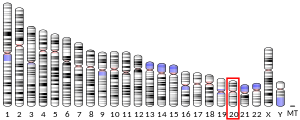From Wikipedia, the free encyclopedia
Protein-coding gene in the species Homo sapiens
Docking protein 5 is a protein that in humans is encoded by the DOK5 gene .[ 5] [ 6]
The protein encoded by this gene is a member of the DOK family of membrane proteins, which are adapter proteins involved in signal transduction. The encoded protein interacts with phosphorylated receptor tyrosine kinases to mediate neurite outgrowth and activation of the MAP kinase pathway. In contrast to other DOK family proteins, this protein does not interact with RASGAP.[ 6]
DOK5 has been shown to interact with RET proto-oncogene .[ 5] [ 7]
^ a b c GRCh38: Ensembl release 89: ENSG00000101134 – Ensembl , May 2017^ a b c GRCm38: Ensembl release 89: ENSMUSG00000027560 – Ensembl , May 2017^ "Human PubMed Reference:" . National Center for Biotechnology Information, U.S. National Library of Medicine .^ "Mouse PubMed Reference:" . National Center for Biotechnology Information, U.S. National Library of Medicine .^ a b Grimm J, Sachs M, Britsch S, Di Cesare S, Schwarz-Romond T, Alitalo K, Birchmeier W (Jul 2001). "Novel p62dok family members, dok-4 and dok-5, are substrates of the c-Ret receptor tyrosine kinase and mediate neuronal differentiation" (PDF) . J Cell Biol . 154 (2): 345– 54. doi :10.1083/jcb.200102032 . PMC 2150770 PMID 11470823 . ^ a b "Entrez Gene: DOK5 docking protein 5" .^ Crowder RJ, Enomoto H, Yang M, Johnson EM, Milbrandt J (2004). "Dok-6, a Novel p62 Dok family member, promotes Ret-mediated neurite outgrowth" . J. Biol. Chem . 279 (40): 42072– 81. doi :10.1074/jbc.M403726200 PMID 15286081 .
Deloukas P, Matthews LH, Ashurst J, et al. (2002). "The DNA sequence and comparative analysis of human chromosome 20" . Nature . 414 (6866): 865– 71. Bibcode :2001Natur.414..865D . doi :10.1038/414865a PMID 11780052 . Shi N, Zhou W, Tang K, et al. (2003). "Expression, crystallization and preliminary X-ray studies of the recombinant PTB domain of human dok-5 protein". Acta Crystallogr. D . 58 (Pt 12): 2170– 2. doi :10.1107/S090744490201644X . PMID 12454490 . Strausberg RL, Feingold EA, Grouse LH, et al. (2003). "Generation and initial analysis of more than 15,000 full-length human and mouse cDNA sequences" . Proc. Natl. Acad. Sci. U.S.A . 99 (26): 16899– 903. Bibcode :2002PNAS...9916899M . doi :10.1073/pnas.242603899 PMC 139241 PMID 12477932 . Favre C, Gérard A, Clauzier E, et al. (2003). "DOK4 and DOK5: new Dok-related genes expressed in human T cells" . Genes Immun . 4 (1): 40– 5. doi :10.1038/sj.gene.6363891 PMID 12595900 . Cai D, Dhe-Paganon S, Melendez PA, et al. (2003). "Two new substrates in insulin signaling, IRS5/DOK4 and IRS6/DOK5" . J. Biol. Chem . 278 (28): 25323– 30. doi :10.1074/jbc.M212430200 PMID 12730241 . Crowder RJ, Enomoto H, Yang M, et al. (2004). "Dok-6, a Novel p62 Dok family member, promotes Ret-mediated neurite outgrowth" . J. Biol. Chem . 279 (40): 42072– 81. doi :10.1074/jbc.M403726200 PMID 15286081 . Gerhard DS, Wagner L, Feingold EA, et al. (2004). "The Status, Quality, and Expansion of the NIH Full-Length cDNA Project: The Mammalian Gene Collection (MGC)" . Genome Res . 14 (10B): 2121– 7. doi :10.1101/gr.2596504 . PMC 528928 PMID 15489334 . Rual JF, Venkatesan K, Hao T, et al. (2005). "Towards a proteome-scale map of the human protein-protein interaction network". Nature . 437 (7062): 1173– 8. Bibcode :2005Natur.437.1173R . doi :10.1038/nature04209 . PMID 16189514 . S2CID 4427026 . Shi L, Yue J, You Y, et al. (2007). "Dok5 is substrate of TrkB and TrkC receptors and involved in neurotrophin induced MAPK activation". Cell. Signal . 18 (11): 1995– 2003. doi :10.1016/j.cellsig.2006.03.007 . PMID 16647839 .







